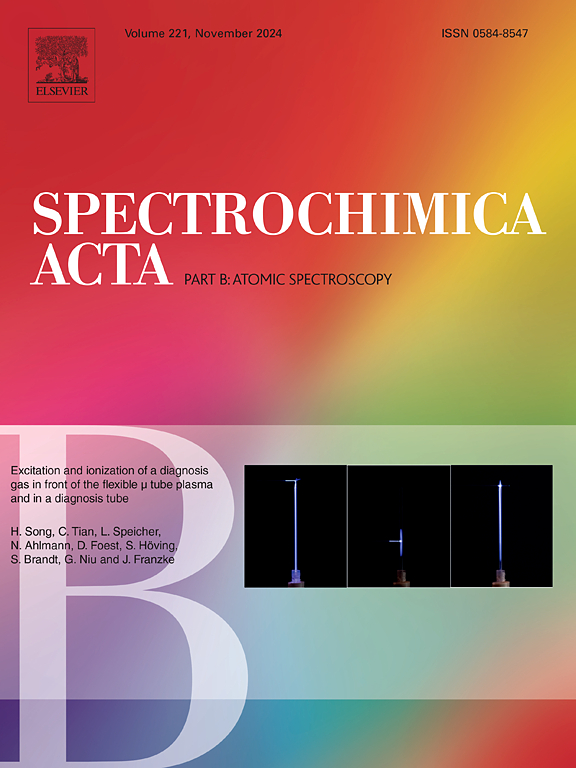Enhancement mechanisms analysis using microwave plasma torch-assisted laser-induced breakdown spectroscopy
IF 3.2
2区 化学
Q1 SPECTROSCOPY
引用次数: 0
Abstract
Laser-induced breakdown spectroscopy (LIBS) has been extensively applied across various fields for elemental analysis, due to its rapid, in-situ, and multi-element detection capabilities. However, its application is often constrained by matrix effects and the weak signal intensity of emission spectra, particularly in the detection of irregular targets and (ultra-)trace elements. To address these challenges, this study introduces an approach to enhance LIBS spectral signal intensity through the assistance of a microwave plasma torch (MPT). Using a pure silicon target, the research systematically examines the primary mechanisms by which MPT influences laser-induced plasma under different laser energy conditions and identifies the sources of signal enhancement, resulting in significant improvements in LIBS spectral intensity. The MPT-assisted enhancement was further validated using an aluminum alloy target, confirming that the effect is non-selective and can significantly improve the LIBS signals for both metallic and non-metallic targets. Overall, by creating an environment that combines the benefits of flame, microwave, and argon gas (Ar), MPT effectively reduces the demands on target surface quality and minimizes target damage during LIBS analysis. This approach offers superior signal enhancement compared to single enhancement methods, positioning MPT as a promising re-excitation strategy in LIBS applications. This capability makes it possible to integrate MPT with compact laser systems, thereby advancing the use of LIBS technology for in-situ and online detection in field or harsh environments.

求助全文
约1分钟内获得全文
求助全文
来源期刊
CiteScore
6.10
自引率
12.10%
发文量
173
审稿时长
81 days
期刊介绍:
Spectrochimica Acta Part B: Atomic Spectroscopy, is intended for the rapid publication of both original work and reviews in the following fields:
Atomic Emission (AES), Atomic Absorption (AAS) and Atomic Fluorescence (AFS) spectroscopy;
Mass Spectrometry (MS) for inorganic analysis covering Spark Source (SS-MS), Inductively Coupled Plasma (ICP-MS), Glow Discharge (GD-MS), and Secondary Ion Mass Spectrometry (SIMS).
Laser induced atomic spectroscopy for inorganic analysis, including non-linear optical laser spectroscopy, covering Laser Enhanced Ionization (LEI), Laser Induced Fluorescence (LIF), Resonance Ionization Spectroscopy (RIS) and Resonance Ionization Mass Spectrometry (RIMS); Laser Induced Breakdown Spectroscopy (LIBS); Cavity Ringdown Spectroscopy (CRDS), Laser Ablation Inductively Coupled Plasma Atomic Emission Spectroscopy (LA-ICP-AES) and Laser Ablation Inductively Coupled Plasma Mass Spectrometry (LA-ICP-MS).
X-ray spectrometry, X-ray Optics and Microanalysis, including X-ray fluorescence spectrometry (XRF) and related techniques, in particular Total-reflection X-ray Fluorescence Spectrometry (TXRF), and Synchrotron Radiation-excited Total reflection XRF (SR-TXRF).
Manuscripts dealing with (i) fundamentals, (ii) methodology development, (iii)instrumentation, and (iv) applications, can be submitted for publication.

 求助内容:
求助内容: 应助结果提醒方式:
应助结果提醒方式:


